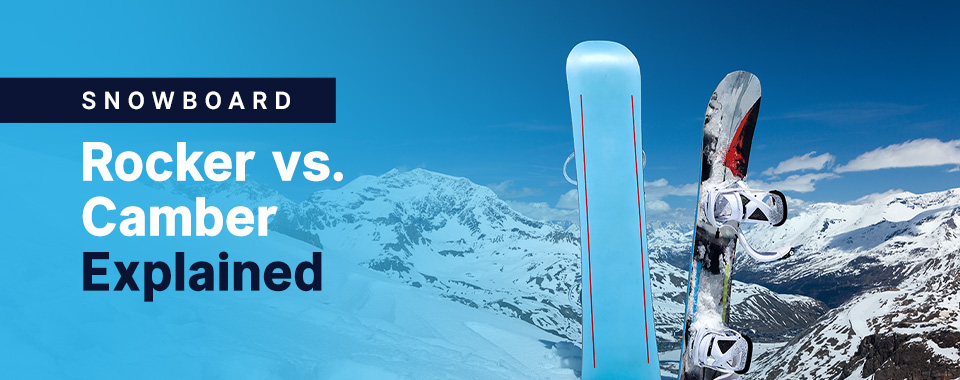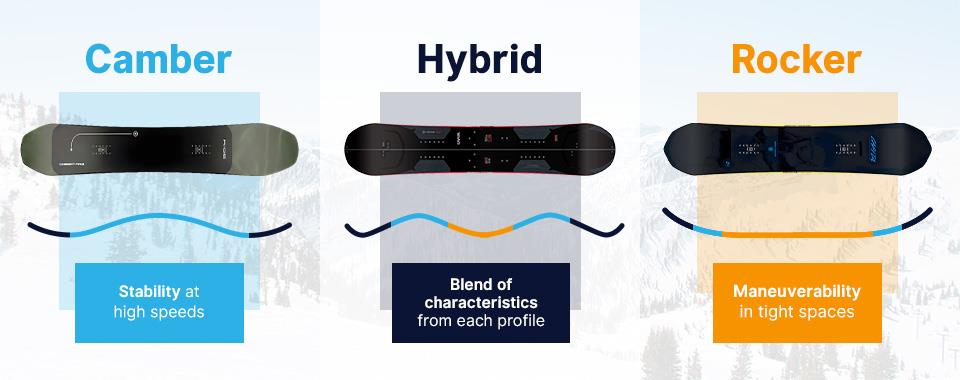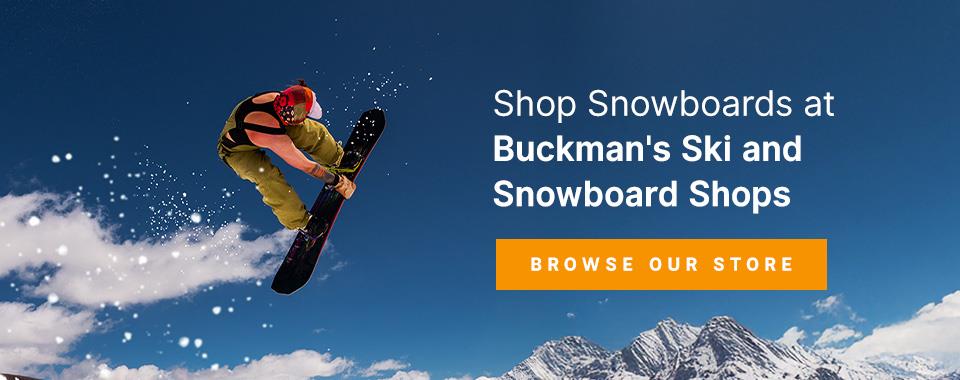 Rocker vs Camber explained
Rocker vs Camber explained
Snowboard Rocker vs Camber Explained
Posted
by
Buckman's Ski & Snowboard Shops
on Thursday, July 3, 2025
Choosing the right snowboard profile can make a big difference in your performance and enjoyment on the slopes. Two of the most common profiles you'll come across are camber and rocker, each with unique characteristics and benefits that greatly influence your ride.
But when weighing camber versus rocker snowboard profiles, it can be challenging to find the right one for you. Understanding the difference between these profiles will help you select the ideal board for your experience level, riding style and preferred terrain.
In this guide, we'll explore rocker and camber snowboard profiles, discussing their distinct features, benefits and how to determine which one best suits your needs.
What Is Camber?
Camber is the traditional snowboard profile. It has been a staple in the industry since the early days of snowboarding. A camber board features an upward arc underfoot, with the contact points — where the board touches the snow — near the tip and tail. This profile creates a spring-like effect, generating pop and responsiveness when pressure is applied.
The upward arc of camber snowboards enhances edge hold and stability, especially at high speeds, making them excel on hardpack and groomed runs. Camber boards are also responsive, making them a favorite among park riders who appreciate the added pop for ollies and jumps.
While traditional camber offers the most pronounced arc, flat-to-camber profiles have recently gained popularity. These boards feature a flat section underfoot with camber toward the tip and tail. This profile provides a more forgiving ride while maintaining many of the benefits of full camber.
What Is Rocker?
Rocker, also known as reverse camber, is essentially the opposite of camber. A rocker snowboard has an upward arc between the bindings, with the contact points closer to the center of the board. This profile creates a looser, more playful feel and enhances float in deep snow.
The upward arc of rocker snowboards increases maneuverability and ease of turning, making them ideal for beginners and those who enjoy a "surfy" feel. The lifted contact points also reduce the likelihood of catching an edge, resulting in a more forgiving and catch-free ride.
Rocker profiles come in two main variations — continuous rocker and flat-to-rocker. Continuous rocker offers a consistent arc from tip to tail, while flat-to-rocker boards have a flat section underfoot with rocker toward the nose and tail. Flat-to-rocker provides a more stable feel than full rocker while offering many of its benefits.
Hybrid Option
If you're looking for the best of both worlds, hybrid profiles like rocker-camber-rocker and camber-rocker-camber offer a blend of characteristics from each profile.
Rocker-camber-rocker boards have rocker in the top and tail for float and catch-free riding, with camber underfoot for pop and edge hold. This profile offers a versatile ride that performs well in deep snow, park and all-mountain scenarios.
Camber-rocker-camber profiles feature camber in the tip and tail for power and response, with rocker between the feet for a looser feel. This profile excels on groomed runs and in the park, providing stability and playfulness.
Camber-rocker hybrids can have a slightly less predictable feel than traditional profiles, and they may not excel in any one specific area compared to pure camber or rocker. They are also typically more expensive than single-profile boards.
What Is the Difference Between Camber and Rocker Snowboards?

When comparing snowboard rocker versus camber profiles, several differences become apparent, including:
- Shape and profile: The most obvious difference between rocker and camber snowboards is their shape. Camber features an upward arc underfoot, with contact points near the tip and tail. In contrast, rocker has an upward arc between the bindings with contact points closer to the center.
- Flex: Camber snowboards typically have a stiffer and more responsive flex pattern. Rocker boards tend to have a softer and more forgiving flex.
- Performance: Camber offers precise edge control, stability at high speeds and pop for jumps. Rocker provides a surfy feel, enhanced float and maneuverability in tight spaces.
Camber vs. Rocker Snowboard: Which Is Best for Your Ride?
When deciding between a snowboard rocker and camber profile, consider several key factors.
Riding Style
Your riding style plays a significant role in determining which profile best suits your needs. If you're a freestyle rider who spends most of your time in the park, the forgiving flex of rocker snowboards makes it easier to perform butters, presses and jibs without catching an edge.
Freeriders often choose camber for its power, stability and edge hold in challenging terrain. The responsive nature of camber allows them to navigate steep lines, charge through variable snow conditions and make precise turns in technical situations.
If you're an all-mountain rider, a hybrid profile is perfect. Hybrid profiles offer a balance of float, maneuverability, edge hold and pop, making them suitable for riders who enjoy a mix of groomers, deep snow and park.
Terrain
Camber performs best on hardpack and well-groomed runs, offering precise edge control and pop for jumps. Its responsiveness and stability make it an excellent choice for carving up corduroy and navigating icy patches.
Rocker excels in deep snow and trees, enhancing float and maneuverability. The upward arc between the bindings allows the board to plane on top of the snow, reducing leg fatigue and providing a surfy feel. In tight tree lines and technical terrain, rocker's quick turning capabilities and forgiving nature come in handy.
Hybrid profiles adapt to a range of conditions, providing a balance for performance across deep snow, groomers or parks.
Skill Level
For beginners, rocker snowboards are more forgiving and easier to learn due to their catch-free nature and seamless turn initiation. The upward arc between the bindings reduces the likelihood of catching an edge, making the learning process less daunting.
If you're an intermediate rider, you can progress with either camber or rocker, depending on your preferred riding style. Camber boards offer responsiveness and pop for developing freestyle skills, while rocker boards provide a more playful and forgiving ride.
Advanced riders often appreciate the power and precision of camber for aggressive riding and technical maneuvers. They may also enjoy the challenge and responsiveness of camber boards in demanding terrain.
Personal Goals
Consider what feels best underfoot and aligns with your riding aspirations. Some riders prefer the lively and responsive feel of camber, while others enjoy rocker's loose and surfy sensation. If you have specific goals, such as improving your freestyle skills or tackling steep terrain, let those objectives guide your decision.
Trying different profiles is the best way to determine which suits you best. Many ski shops offer demo days or rental programs, allowing you to try various boards and profiles. Take advantage of these opportunities to see how each profile performs and responds to your riding style.
Shop Snowboards at Buckman's Ski and Snowboard Shops
Understanding the differences between camber and rocker snowboards is essential to finding your perfect board. Whether you prefer the power and pop of camber, the playfulness and float of rocker or the versatility of a hybrid profile, the right board is waiting for you at Buckman’s Ski and Snowboard Shops.
As a family-owned business with a passion for snowboarding, we offer an extensive selection of the best boards from elite brands. Our knowledgeable staff is here to provide expert advice and personalized recommendations, helping you find the ideal setup for your riding style and goals.
Experience the difference of shopping with a retailer who cares about your success on the mountain. Browse our online store or visit one of our locations in Eastern Pennsylvania to find your dream snowboard today.

Categories:
Snowboard Equipment